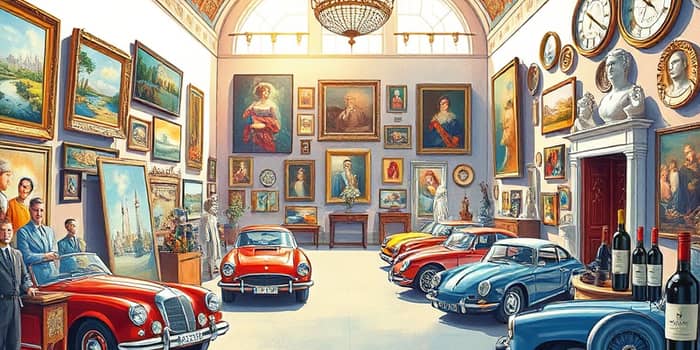In a world dominated by equities, bonds, and real estate, art and collectibles stand out as compelling alternatives. These tangible assets offer investors a way to buffer against market turbulence and tap into a realm of passion-driven value.
By embracing a broad spectrum of asset classes, you can reduce overall portfolio risk and uncover unique opportunities for growth and enjoyment. This journey demands both financial insight and cultural appreciation, merging the analytical with the aesthetic.
The Rising Canvas: Growth of Art and Collectibles Markets
The global art market has surged from around $39.5 billion in annual sales in 2009 to over $64 billion by 2019. Today, it’s estimated at nearly $1.7 trillion in total value. Fine art, rare coins, classic cars, and vintage wine have all captured investor interest.
This expansion reflects both increased wealth among high-net-worth individuals and the emergence of middle-class collectors. As traditional markets ebb and flow, these tangible assets continue to attract capital for their potential for long-term appreciation and aesthetic appeal.
Why Alternative Assets Deserve a Place in Your Portfolio
Traditional diversification typically involves stocks, bonds, and real estate. Yet alternative assets like art and collectibles can provide an additional layer of protection. Their values often move independently of mainstream markets, giving investors a strategic edge.
- low or even negative correlation with equities and bonds
- potential for long-term appreciation through rarity and provenance
- tangible and intrinsic cultural value that transcends financial metrics
- emotional rewards from displaying and enjoying cherished pieces
These benefits illustrate why 52% of collectors cite diversification as a primary motivation. Allocating a modest portion of your portfolio to alternative assets can enhance resilience and unlock novel return streams.
Weighing Returns Against Risks
Performance data underscores the appeal of collecting: the Artprice100 index, tracking top blue-chip artists, delivered average annual returns of 8.9% between 2008 and 2018. Over that period, it outpaced the S&P 500 by more than 250%.
Despite these impressive figures, investors must navigate significant challenges. The art and collectibles world presents complex challenges like valuation difficulty and illiquidity. Market tastes shift rapidly, and transactions can take months to complete.
Additional risks include the threat of forgeries, high holding costs for insurance and storage, and vulnerability to economic downturns that dampen discretionary spending.
Strategies for Building a Balanced Collection
Creating a resilient alternative-asset portfolio requires careful planning. Diversity remains key, even within the realm of art and collectibles. Spreading investments across multiple sectors helps buffer against sector-specific downturns.
- Collect across different categories: fine art, classic cars, rare coins, vintage wine
- Diversify by period, artist, and artistic style to avoid trend dependency
- Explore geographic and cultural regions for fresh opportunities
- Set clear limits on allocation to illiquid assets for risk control
This approach aligns with portfolio optimization research, which favors moderate weights for illiquid assets. By resisting the urge to chase fads, you can build a collection that weathers changing collector preferences and economic cycles.
Practical Steps to Get Started
Embarking on collecting demands both passion and prudence. Begin with thorough research into provenance, market history, and condition reports. Familiarize yourself with auction records and gallery pricing trends.
Work exclusively with reputable dealers, auction houses, and certified appraisers to minimize fraud risk. Factor in all ownership costs, including storage, insurance, conservation, and transaction fees.
Adopt a long-term horizon: masterpieces and rare collectibles often appreciate over decades rather than months. Patience and discipline remain your greatest allies.
The Future of Diversification: Digital and Fractional Ownership
Recent innovations are reshaping access to art and collectibles. Digital platforms now enable fractional ownership of high-value works, allowing smaller investors to participate in blue-chip markets once reserved for elites.
Non-fungible tokens (NFTs) and online auction houses are democratizing access for a broader audience. As technology evolves, we expect a proliferation of curated investment funds and tokenized collectibles.
This digital transformation promises to expand liquidity and transparency, reducing barriers while preserving the thrill of collecting.
Investing in art and collectibles can be a powerful complement to traditional portfolios. By embracing strategic portfolio diversification and balancing passion with process, you can construct a resilient, enriching asset mix that stands the test of time.
References
- https://www.kubera.com/blog/art-investing
- https://www.wealthformula.com/blog/investing-in-art-and-collectibles/
- https://quantpedia.com/portfolio-diversification-including-art-as-an-alternative-asset/
- https://blog.dutchmendenhall.com/the-potential-of-art-and-collectibles
- https://www.financialsamurai.com/portfolio-diversification-with-alternative-investments-art-farmland-wine/
- https://www.composition.gallery/journal/the-collector-s-palette-the-importance-of-diversity-in-art-investment/
- https://www.bankrate.com/investing/diversification-is-important-in-investing/
- https://insights.masterworks.com/alternative-investments/collectibles-as-investments/










